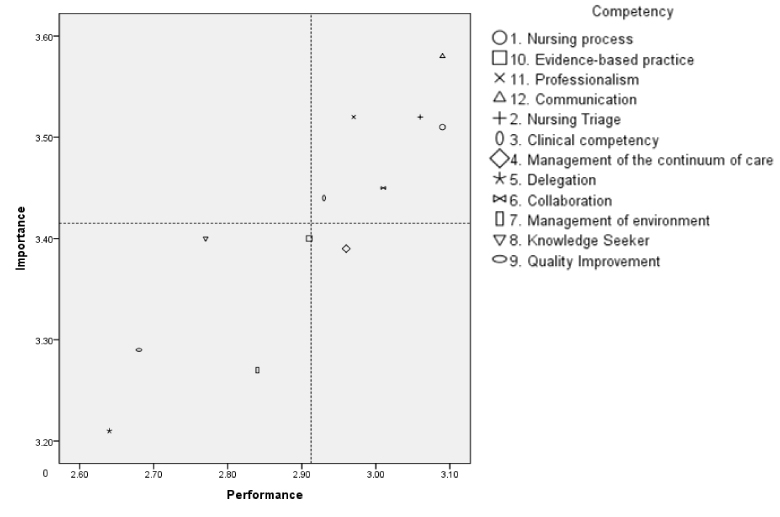J Korean Acad Nurs Adm.
2017 Jan;23(1):90-100. 10.11111/jkana.2017.23.1.90.
Developing of a Tool for Ambulatory Care Nurse Competencies
- Affiliations
-
- 1CHA Bundang Medical Center, CHA University, Korea.
- 2College of Nursing, CHA University, Korea. yusso2012@daum.net
- KMID: 2369522
- DOI: http://doi.org/10.11111/jkana.2017.23.1.90
Abstract
- PURPOSE
The purpose of this study was to develop a tool to evaluate the nursing competency of ambulatory nurses and to verify the reliability and validity of the developed tool for use in general hospitals.
METHODS
The evaluation tool for ambulatory nursing competency was developed through a literature review and tests for validity and reliability.
RESULTS
Subsequent to a review of the literature on nursing performance of ambulatory nurses, a 12 item questionnaire was developed. Through factor analysis, 12 items in a 2 factor solution were derived. Cronbach's α coefficient of the final instrument was .86.
CONCLUSION
The assessment tool developed in this study allows for objective assessments of nursing competencies in relation to the competencies expected of ambulatory care nurses. It is hoped that the assessment tool can be used for empirical verification and to provide basic data for establishing the necessary policies to secure outstanding human resources.
Figure
Reference
-
1. Allen JW. Transitioning the RN to ambulatory care: An investment in orientation. Nurs Adm Q. 2016; 40(2):115–121. DOI: 10.1097/naq.0000000000000151.2. American Hospital Association. Chartbook: trends affecting hospitals and health systems [Internet]. cited 2016 December 1. Available from: http://www.aha.org/research/reports/tw/chartbook/ch3.shtml.3. Statistics Korea. Number of daily outpatients per year [Internet]. cited 2016 December 1. Available from: http://kosis.kr/statHtml/statHtml.do?orgId=117&tblId=DT_11730_N007&conn_path=I2.4. Mastal M, Matlock AM, Start R. Ambulatory care nurse-sensitive indicators series: Capturing the role of nursing in ambulatory care--the case for meaningful nurse-sensitive measurement. Nurs Econ. 2016; 34(2):92–97.5. Committee on the Robert Wood Johnson Foundation Initiative on the Future of Nursing. at the Institute of Medicine. Robert Wood Johnson Foundation. Institute of Medicine (US). The future of nursing: leading change, advancing health. Washington, D.C.: National Academies Press;2011.6. American Academy of Ambulatory Care Nursing Task Force. Definition of professional ambulatory care nursing [Internet]. Pitman, NJ: American Academy of Ambulatory Care Nursing;2011. updated 2011 March 8. cited 2016 December 1. Available from: http://www.aaacn.org/sites/default/files/AmbulatoryCareNursingDefinition.pdf.7. Swan BA, Haas SA, Chow M. Ambulatory care registered nurse performance measurement. Nurs Econ. 2010; 28(5):337–339. 3428. Benner P. From novice to expert. Am J Nurs. 1982; 82(3):402–407.9. While AE. Competence versus performance: Which is more important? J Adv Nurs. 1994; 20(3):525–531. DOI: 10.1111/j.1365-2648.1994.tb02391.x.10. Kang YS, Lee SJ, Kim IJ, Ahn KH. A measurement scale development of nursing competence for nurses working in general wards. J Korean Acad Nurs Adm. 2008; 14(3):219–228.11. Park MR, Kim NC. Development of a nursing competence measurement scale according to nurse's clinical ladder in general wards. J Korean Acad Nurs Adm. 2014; 20(3):257–271. DOI: 10.11111/jkana.2014.20.3.257.12. Park KO, Lee YY. Developing a performance appraisal tool for neonatal intensive care unit registered nurses. J Korean Acad Soc Nurs Educ. 2011; 17(2):267–276.13. Park SA, Park KO, Kim MS, Yoon GS, Lee YY. Development of performance evaluation tool for operating room nurses. J Korean Clin Nurs Res. 2008; 14(1):71–84.14. Lee YY. Development of a performance appraisal tool for postoperative anesthesia care unit nurses. J Korean Acad Nurs Adm. 2016; 22(3):270–278. DOI: 10.11111/jkana.2016.22.3.270.15. Hwang HY, Park JH, Kim JS, Chen IS, Kim MS, Bae KO, et al. A study on the performance and the importance of ambulatory nursing activities. J Korean Acad Nurs Adm. 2007; 13(1):109–117.16. Song MR, Park KJ. Emotional labor experienced by ambulatory care nurses. J Korean Acad Nurs Adm. 2011; 17(4):451–461. DOI: 10.11111/jkana.2011.17.4.451.17. Carper B. Fundamental patterns of knowing in nursing. ANS Adv Nurs Sci. 1978; 1(1):13–23.18. Jang KS. A study on establishment of clinical career development model of nurses [dissertation]. Seoul: Yonsei University;2000.19. Manz CC. The art of self-leadership: strategies for personal effectiveness in your life and work. Englewood Cliffs, NJ: Prentice-Hall;1983.20. Kim HS. The relation between self-leadership and job satisfaction of middle school teachers [master's thesis]. Seoul: Soongsil University;2003.21. Seomun GA, Chang SO, Cho KH, Kim IA, Lee SJ. The relation between self-leadership and outcome of nursing practice. J Korean Acad Nurs Adm. 2006; 12(1):151–158.22. Han Y, Park Y. Effects of self-leadership and job involvement on clinical competence in general hospital nurses. J Korean Acad Nurs Adm. 2013; 19(4):462–469. DOI: 10.11111/jkana.2013.19.4.462.23. Ryu JM, Kim MS. Influence of professional self-concept, self-leadership on elderly care performance of geriatric hospital nurses. J Health Info Stat. 2016; 41(4):392–402.24. Ha NS, Choi J. An analysis of nursing competency affecting on job satisfaction and nursing performance among clinical nurses. J Korean Acad Nurs Adm. 2010; 16(3):286–294. DOI: 10.11111/jkana.2010.16.3.286.25. Kim HS, Min S, Im SI. The effect of nurse's competency empowerment and boss' job competency recognition level on work performance. Korean J Occup Health Nurs. 2013; 22(2):75–82. DOI: 10.5807/kjohn.2013.22.2.75.26. Ko YK, Lee TW, Lim JY. Development of a performance measurement scale for hospital nurses. J Korean Acad Nurs. 2007; 37(3):286–294.27. Martilla JA, James JC. Importance-performance analysis. J Mark. 1977; 41(1):77–79. DOI: 10.2307/1250495.28. Kalb KB, Cherry NM, Kauzloric J, Brender A, Green K, Miyagawa L, et al. A competency-based approach to public health nursing performance appraisal. Public Health Nurs. 2006; 23(2):115–138. DOI: 10.1111/j.1525-1446.2006.230204.x.29. Loyola University Health System. Ambulatory & specialty criteria [Internet]. 2001. updated 2014 May 15. cited 2015 July 8. Available from: http://www.luhs.org/feature/nursing/Clinical_Ladder/Criterion/CLADAmb.spec%20combo.2009.pdf.30. Baghi H, Panniers TL, Smolenski MC. Description of practice as an ambulatory care nurse: psychometric properties of a practice-analysis survey. J Nurs Meas. 2007; 15(1):62–76. DOI: 10.1891/106137407780851787.
- Full Text Links
- Actions
-
Cited
- CITED
-
- Close
- Share
- Similar articles
-
- Need analysis for managerial competencies of nurse managers in general hospitals
- Core Competencies for New Nurses
- Preparing for the Trend of Aging in Place: Identifying Interprofessional Competencies for Integrated Care Professionals
- Development and Validation of a Tool for Evaluating Core Competencies in Nursing Cancer Patients on Chemotherapy
- A Study on the Classification of Nursing Management Competencies and Development of related Behavioral Indicators in Hospitals


